How Italy is bringing its ghost towns back to life
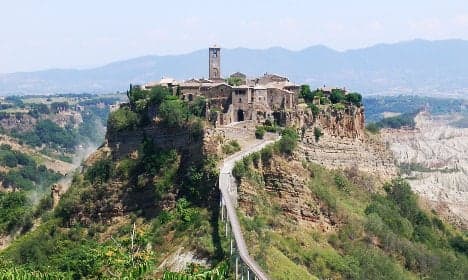
Earthquakes or unemployment drove the original inhabitants away; now some of Italy’s ghost towns are being revived as trendy holiday spots or even hippy artists’ communes. And if that doesn’t work? Flog it on eBay.
The stunning clifftop town of Civita di Bagnoregio was once considered the “jewel city of the Tiber Valley”. But in the 17th century the town declined rapidly, due to earthquakes and soil erosion which sent many of its medieval buildings tumbling down the cliffs, and the inhabitants fleeing to nearby towns.
Nowadays it can only be reached by a narrow walkway, and the erosion is worse than ever. It is nicknamed “il paese che muore”, the dying town. So how do you bring a dying town back to life?
A petition to have the unique hamlet classed as a Unesco World Heritage site was started in May by Nicola Zingaretti, president of Lazio, the region in which the village is found. It has been signed by cultural heavyweights like Ennio Morricone, the film composer, and former Italian president Giorgio Napolitano.
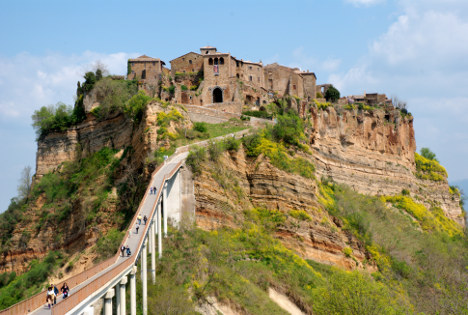
Civita di Bagnoregio. Photo: Etnoy/Wikicommons
But locals are pessimistic about the town’s chances unless they receive international help. “Such a small community cannot prevent the collapse of the town,” resident Celestino Visconti told La Stampa.
Another town attracted the attention of an entrepreneur, who saw its tumbledown buildings as a business opportunity.
Santo Stefano di Sessanio was abandoned in the 19th century when the area’s wool trade declined. However, in 2004, Daniele Kihlgren bought up several dilapidated properties, to turn them into an “albergo diffuso” (“spread-out hotel”), called Sextantio.
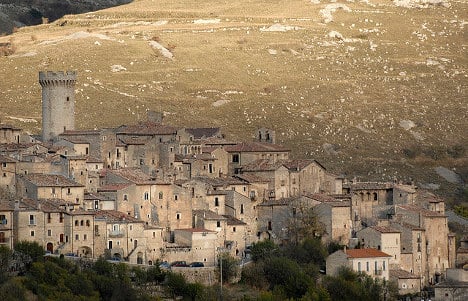
Santo Stefano di Sessanio. Photo: Angelo Amboldi
The “rooms” of the hotel are in fact placed throughout the village, using various buildings, including the old brothel. They have WiFi and underfloor heating while maintaining a rustic style. Rooms cost between €150 and €400 a night.
Since then, the village’s fortunes have improved. Less that two hours’ drive from Rome, it has become a fashionable spot, and Italians are buying run-down houses to turn into weekend homes.
But how do you advertise a run-down village? Pratariccia in Tuscany might be a Medieval village, but the authorities of the abandoned town had some modern ideas.
In 2012 the hamlet was advertised on eBay for €2.5 million. The “owners” of the area, who wished to remain anonymous but are believed to be a monastic order, wanted to sell as fast as possible. The company handling the sale, LPQ Immobiliaire, told the Daily Mail they had received “a number of interesting bids”.
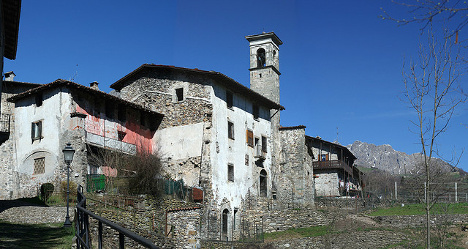
Pratariccia. Photo: Rowena
However, it has never emerged whether or not a sale went through. Perhaps potential buyers were put off by the advertisement that said it “needed restoration”. After all, when most real estate agents talk about “needing restoration”, they don’t mean, “You have to walk the last 800 meters because there are no roads.”
Another ghost town has been re-inhabited by a group who might sneer at such a bourgeois undertaking. Bussana Vecchia has become a ghost town twice, and been revived twice: in 1887 the inhabitants fled after an earthquake, but by the 1940s it was re-populated with migrant Southern workers squatting. They were evicted in the 1950s, and the town was abandoned again for a decade. Then a group of artists took over the town, rechristening it the International Artists Village.
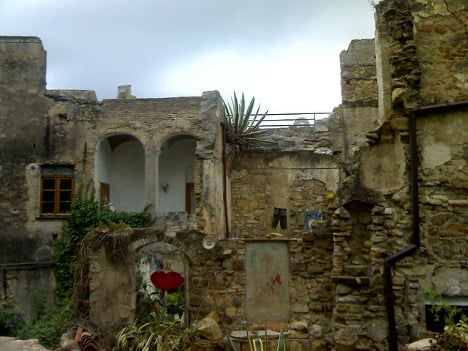
Bussana Vecchia. Photo: Agostino Fedeli
Francis Shaw, a British composer who has been living part-time in Bussana Vecchia since 1968, told The Local that they had no water or electricity. However, after spending a considerable amount of time and money renovating the town, on the understanding that the Italian government would accept them as the owners of the properties they had fixed, the artists were later told that the government considered them squatters and wanted to list the town as a historic monument.
Many of the new inhabitants believe that the authorities are scamming them: the government originally wanted to bulldoze the area, deeming it “unsafe”, but now that property prices in the area have increased, they hope to profit by selling the houses. Some of the court cases have continued for 17 years.
But what happens to the other ghost towns that haven’t attracted this attention? They haven’t been forgotten.
Frattura Vecchia di Scanno was once a prosperous agricultural town, but was uninhabited by the 1950s. But their descendants return a few times every year, to mark their heritage. On holy days they hold processions through the town and celebrate in the square. A lively occasion, not a ghostly danse macabre.
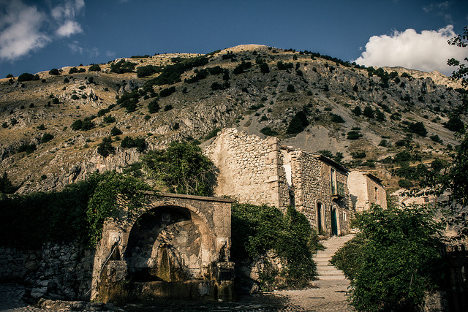
Frattura Vecchia di Scanno. Photo: Pierfilippo Mancini
By Louise Naudé
Comments
See Also
The stunning clifftop town of Civita di Bagnoregio was once considered the “jewel city of the Tiber Valley”. But in the 17th century the town declined rapidly, due to earthquakes and soil erosion which sent many of its medieval buildings tumbling down the cliffs, and the inhabitants fleeing to nearby towns.
Nowadays it can only be reached by a narrow walkway, and the erosion is worse than ever. It is nicknamed “il paese che muore”, the dying town. So how do you bring a dying town back to life?
A petition to have the unique hamlet classed as a Unesco World Heritage site was started in May by Nicola Zingaretti, president of Lazio, the region in which the village is found. It has been signed by cultural heavyweights like Ennio Morricone, the film composer, and former Italian president Giorgio Napolitano.

Civita di Bagnoregio. Photo: Etnoy/Wikicommons
But locals are pessimistic about the town’s chances unless they receive international help. “Such a small community cannot prevent the collapse of the town,” resident Celestino Visconti told La Stampa.
Another town attracted the attention of an entrepreneur, who saw its tumbledown buildings as a business opportunity.
Santo Stefano di Sessanio was abandoned in the 19th century when the area’s wool trade declined. However, in 2004, Daniele Kihlgren bought up several dilapidated properties, to turn them into an “albergo diffuso” (“spread-out hotel”), called Sextantio.

Santo Stefano di Sessanio. Photo: Angelo Amboldi
The “rooms” of the hotel are in fact placed throughout the village, using various buildings, including the old brothel. They have WiFi and underfloor heating while maintaining a rustic style. Rooms cost between €150 and €400 a night.
Since then, the village’s fortunes have improved. Less that two hours’ drive from Rome, it has become a fashionable spot, and Italians are buying run-down houses to turn into weekend homes.
But how do you advertise a run-down village? Pratariccia in Tuscany might be a Medieval village, but the authorities of the abandoned town had some modern ideas.
In 2012 the hamlet was advertised on eBay for €2.5 million. The “owners” of the area, who wished to remain anonymous but are believed to be a monastic order, wanted to sell as fast as possible. The company handling the sale, LPQ Immobiliaire, told the Daily Mail they had received “a number of interesting bids”.

Pratariccia. Photo: Rowena
However, it has never emerged whether or not a sale went through. Perhaps potential buyers were put off by the advertisement that said it “needed restoration”. After all, when most real estate agents talk about “needing restoration”, they don’t mean, “You have to walk the last 800 meters because there are no roads.”
Another ghost town has been re-inhabited by a group who might sneer at such a bourgeois undertaking. Bussana Vecchia has become a ghost town twice, and been revived twice: in 1887 the inhabitants fled after an earthquake, but by the 1940s it was re-populated with migrant Southern workers squatting. They were evicted in the 1950s, and the town was abandoned again for a decade. Then a group of artists took over the town, rechristening it the International Artists Village.

Bussana Vecchia. Photo: Agostino Fedeli
Francis Shaw, a British composer who has been living part-time in Bussana Vecchia since 1968, told The Local that they had no water or electricity. However, after spending a considerable amount of time and money renovating the town, on the understanding that the Italian government would accept them as the owners of the properties they had fixed, the artists were later told that the government considered them squatters and wanted to list the town as a historic monument.
Many of the new inhabitants believe that the authorities are scamming them: the government originally wanted to bulldoze the area, deeming it “unsafe”, but now that property prices in the area have increased, they hope to profit by selling the houses. Some of the court cases have continued for 17 years.
But what happens to the other ghost towns that haven’t attracted this attention? They haven’t been forgotten.
Frattura Vecchia di Scanno was once a prosperous agricultural town, but was uninhabited by the 1950s. But their descendants return a few times every year, to mark their heritage. On holy days they hold processions through the town and celebrate in the square. A lively occasion, not a ghostly danse macabre.

Frattura Vecchia di Scanno. Photo: Pierfilippo Mancini
By Louise Naudé
Join the conversation in our comments section below. Share your own views and experience and if you have a question or suggestion for our journalists then email us at [email protected].
Please keep comments civil, constructive and on topic – and make sure to read our terms of use before getting involved.
Please log in here to leave a comment.